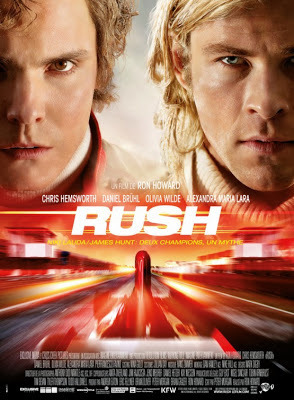"Rush": Capturing the Need for Speed

I didn’t rush out to see Rushwhen it was newly released. Movies about Formula One auto racing are not my idea of summer fun. I’m a veteran of L.A.’s mean streets and meaner freeways, which means I consider driving a chore, not an art form. Still, as Ron Howard’s biographer, I felt obligated to look in on his latest project. And so, because I suspected that Rush deserved to be seen on the big screen, I headed for a matinee at the trendy Landmark Theater complex in West L.A. I curled up on a comfy leather couch in the Landmark’s “screening lounge” – and found myself mesmerized by this real-life tale of two drivers who found very different ways of getting to the finish line.
Ron Howard, of course, made his directorial debut with a race car movie. That was back in 1977, when the 23-year-old Howard persuaded Roger Corman (who else?) to let him follow up a starring role in Eat My Dust with another teen car-crash comedy called Grand Theft Auto. He co-wrote the script with his father Rance, played the male lead, and brought in the movie on time and on budget. Given that he was allotted a mere $602,000 and a shooting schedule of only 23 days, speed and efficiency were crucial. Howard remains proud of having broken the previous New World Pictures record by achieving ninety-one camera set-ups in a single day.
Obviously, Rush cost much more and took much longer to shoot. But the economy of means that Howard learned from his Corman days obviously helped shape this complex film. Its script, by the talented Peter Morgan, is strong, as are the performances of the two lead actors, Daniel Brühl (as Austria’s Niki Lauda) and Chris Hemsworth (as British bad-boy James Hunt). Yet I consider it above all a triumph of cinematography and editing. The impressionistic camerawork of Anthony Dod Mantle (known for Slumdog Millionaire and 127 Hours) puts the viewer in the driver’s seat, and Howard’s longtime editors Dan Hanley and Mike Hill seamlessly intercut the cheering throngs, the rain-soaked tracks, the pulsing pitons of the world’s fastest cars to get me caught up in the action. Normally when it comes to the finer points of auto mechanics, I don’t go beyond listening to Car Talk, and yet I could easily follow the story’s technical twists and turns. And, though I had some inkling of what was coming, I was gripped with anticipation.
Which for me made Rush the antithesis of Gravity. That film was quiet, set against empty spaces. This one is packed with people, places, noise. Yet they’re both, in their way, about survival. For me, anyway, Rush was the one that had me on the edge of my seat.
Given what I know of Ron Howard, I believe he can strongly identify with Lauda, the methodical pragmatist who badly wanted to win, but also wanted to live to race another day. Yet I also believe Howard is dazzled (as Lauda apparently was) by the glamorous, devil-may-care James Hunt. The tension between these two very different champions, on the track and off, is part of what makes Rush so thrilling. But champions also need teams behind them, just as Howard has relied throughout his career on a loyal production team that rarely changes. Howard’s skill as a team leader is part of why he has Hollywood’s respect, and mine too.
I must confess, when I headed out of the parking garage and into a sunny L.A. afternoon, that I was tempted to put a little extra vroom-vroom into my drive home.
Published on October 15, 2013 09:29
No comments have been added yet.
Beverly in Movieland
I write twice weekly, covering topics relating to movies, moviemaking, and growing up Hollywood-adjacent. I believe that movies can change lives, and I'm always happy to hear from readers who'd like t
I write twice weekly, covering topics relating to movies, moviemaking, and growing up Hollywood-adjacent. I believe that movies can change lives, and I'm always happy to hear from readers who'd like to discuss that point.
...more
- Beverly Gray's profile
- 10 followers



